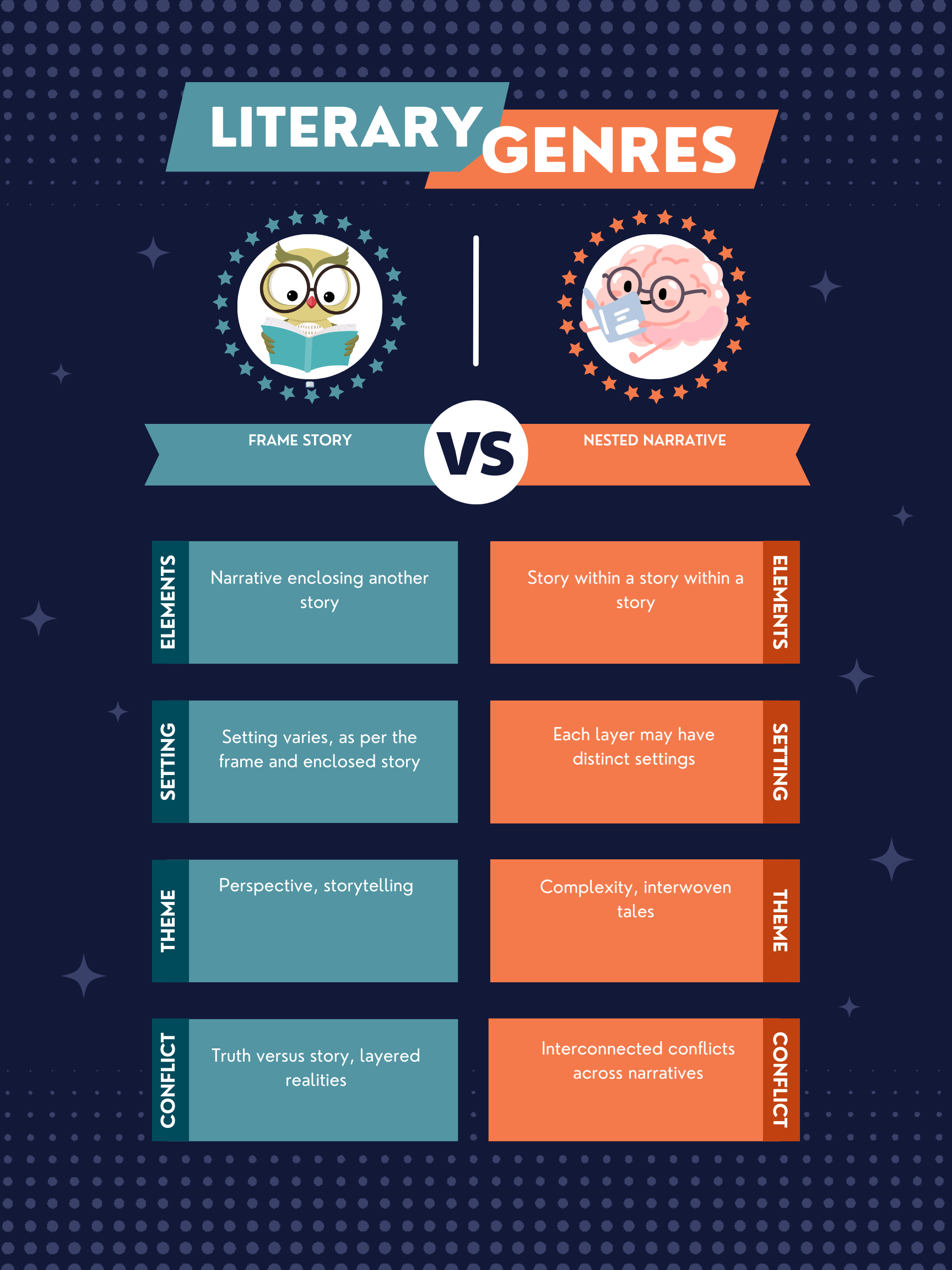A Frame Story is a narrative technique where a main story encompasses one or more separate stories within it; Nested Narrative specifically refers to stories within a story, each potentially adding depth or context to the others.
Both frame stories and nested narratives invite readers into a world where stories unfold within other stories, creating a richly layered narrative experience. Let’s explore these fascinating storytelling structures. 📚🖼️
Frame Story
A frame story, or a framing device, serves as the outer shell of the narrative, within which one or more stories are told. Geoffrey Chaucer’s “The Canterbury Tales” is a classic example, where the pilgrimage provides a framework for the pilgrims’ individual tales.
Nested Narrative
Nested narratives involve stories embedded within each other, often with different narrators or perspectives. These can add complexity and depth, offering insights into the main narrative or characters. An example is Emily Brontë’s “Wuthering Heights,” where the story is told through several layers of narration, deeply entwining the fates of the characters.
Summary
| Literary Device | Definition | Purpose | Usage | Relevant Examples |
|---|---|---|---|---|
| Frame Story | A narrative technique where a main story encompasses separate stories within it. | To provide a unifying context for multiple stories. | Novels, short story collections. | “The Canterbury Tales” by Geoffrey Chaucer. |
| Nested Narrative | Stories within a story, each adding depth or context to the others. | To add complexity and depth to the main narrative. | Novels, films, oral storytelling. | “Wuthering Heights” by Emily Brontë. |
Writing Tips
For Frame Story:
- Clear Framework: Establish a strong, engaging frame story that can support and unify the inner stories.
- Maintain Coherence: Ensure that the inner stories contribute to the overall narrative or theme of the frame story.
- Transition Smoothly: Use clear transitions between the frame and the inner stories to maintain narrative flow.
For Nested Narrative:
- Depth and Complexity: Utilize nested narratives to explore themes or characters from multiple perspectives.
- Keep Clarity: Despite the complexity, maintain clarity in who is narrating and how each story relates to the others.
- Balance the Stories: Ensure each nested story holds its weight and significance within the overall narrative.
FAQs
Can a frame story have nested narratives?
Yes, a frame story can contain nested narratives, further enriching the storytelling experience by adding layers of depth.
How do readers benefit from these techniques?
These techniques can enhance the reader’s engagement and investment in the story, offering multiple angles and insights into the narrative and characters.
Exercise
Read the following excerpt: “Around the fire, the old man began his tale of a young wanderer, who, in his travels, encountered a mysterious storyteller with his own set of tales.”
Answer: This passage suggests a frame story that potentially leads into nested narratives, with the old man’s tale framing the young wanderer’s story, which in turn could introduce further stories.
Other Interesting Literary Device Comparisons
- Direct vs Indirect Characterization: Direct characterization explicitly describes a character’s traits, while indirect characterization reveals traits through actions, speech, and other characters’ reactions.
- Allegory vs Symbolism: Allegory is a narrative with a dual meaning where every aspect symbolizes deeper ideas, whereas symbolism uses specific symbols to signify ideas and qualities.
- First-Person vs Third-Person Point of View: First-person narration is told from the perspective of a character within the story, while third-person narration provides an outside perspective, which can be omniscient or limited.
Exploring the intricacies of frame stories and nested narratives reveals the endless possibilities for creativity in storytelling, enriching both the narrative depth and the reader’s experience. 📖✨

